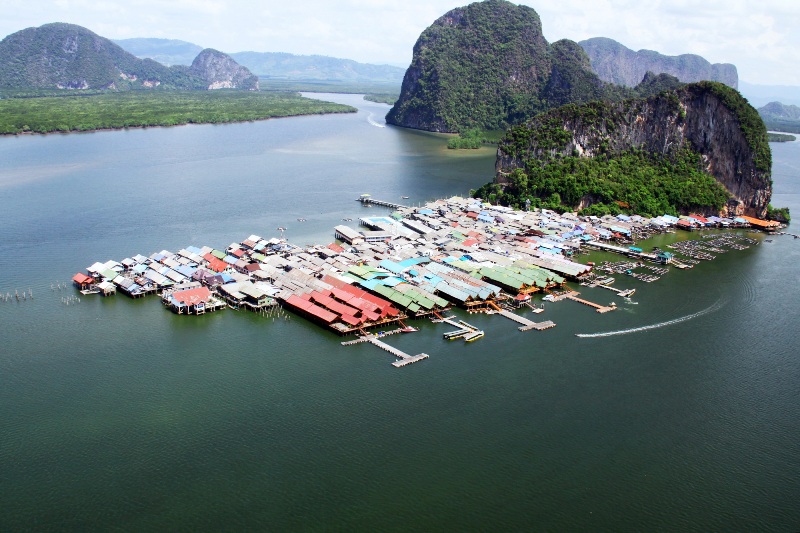Thailand is one of the world’s prime tourist destinations and seen as something of a haven for those seeking to practice Buddhism. And whilst a vast majority of the country’s 67 million inhabitants do practice the religion, the country also has a somewhat diverse minority population.
Islam in Thailand, largely existent in the countries south, is reported to sit at around 4 million mostly-sunni Muslims, many of whom originate from other South East, and Central Asian countries. Whilst the country may be synonymous for its islands and beaches that rake in millions of tourists each year, the cultural presence in Thailand is amongst the richest in Asia.
Take for example Koy Panyi, a small fishing village situated at the tip of the Andaman Sea. Take an hour’s boat ride from the tourist hotspot of Phuket, or just a few minutes south from the Phang Nga province, and you will find a small, almost entirely Muslim settlement across the backdrop of a limestone island. What makes this quaint and picturesque village so significant however, is the fact that the settlement itself is built almost entirely on stilts.
Indonesian origins
The residents of Koy Panyi, a meager 1600 people compromising around 360 families, are reported to be descendents from three families of nomadic Indonesian fishermen, who set sail from the island of Java almost 200 years ago. As local legend goes, the families sailed northwards in the hope of finding a new home. Upon entering the Andaman Sea, they went separate ways and vowed to hoist a flag to indicate to the others once they found a location hospitable, as well as conducive for fishing. It is believed that this is what led to the name Koh Panyi (Flag Village).
What gives credibility to this legend is that at the time, Thai law restricted land ownership in the country to the indigenous population. The families were able to work around this by constructing the settlement in the middle of the ocean, next to a small land mass. As Thai laws eased, and with the village becoming a notable tourist destination, inhabitants were later able to buy property on the island itself.
Key tourist destination
Whilst the core of the community’s income is based off its fishing industry, tourism is also seen as a vital fixture in the resident’s daily lives. Set foot on the encampment with one of the popular day tours and the first things that will greet you are a popular seafood restaurant and a small souvenir shop. Delve a little deeper and you will find a network of markets that span a large portion of the village. Tourism’s importance is to such an extent, that many inhabitants and shop owners choose to live in small rooms and houses situated just behind their stores.
And although the settlement has not been left untouched by the tourism boom that has affected so many parts of Thailand, the village and its residents still remain true to themselves. Most still uphold their Islamic values, with alcohol and pork strictly forbidden in the village, and scantily dressed tourists frowned upon.
Mosque on the sea and floating field
Despite limited space, and the obvious obstacle of trying to construct on an outpost in the middle of the ocean, Koy Panyi residents have made the most of their situation. This has seen the construction of several major structures catered to the needs of the people; from an informal school (with a playground), a police station, healthcare centre, water well, and most impressively a mosque. Although technically situated on the island adjacent to the village, the latter is still an impressive feature that serves as the life and blood of this small community.
Another notably impressive feature of Koh Panyi is arguably its ‘one-of-a-kind’ floating football pitch, built in 1986 by a group of Muslim children almost entirely with old pieces of wood and fishing rafts. The children, inspired by the year’s Fifa World Cup and despite being dismissed by residents, decided to form a football team in the heart of the ocean. Panyee FC, as the team became known, achieved surprising success in a mainland tournament, eventually growing into amongst the most recognized youth teams in Thailand. In later years a secondary improved pitch was built, with a new generation of players continuing to carry the team forward.
2004 Tsunami
As tour guides and locals will be keen to point out, the village, despite being seemingly vulnerable to storms and natural disasters, was miraculously left unaffected by the 2004 Tsunami that otherwise devastated the region. Whilst nearby islands and towns were left in ruins as a result of the disaster, the settlement’s strategic location meant that its infrastructure and inhabitants were left completely unscathed.
Koh Panyi serves as a lunch stop for those taking the island hopping tours from the nearby province of Phuket, serving as a quieter option than the party-crazed Koh Phi Phi (Phi Phi Island). It also provides a uniquely cultural and eye-opening experience, of a small Muslim community able to thrive in what should be the most inhospitable of areas. Here a community of just under 2000 lives the most accurate definition of ‘the simple life’, whilst still preserving and upholding their Islamic identity. VOC (Mubeen Banderker)









 WhatsApp us
WhatsApp us 

